#link: justinian
Explore tagged Tumblr posts
Text
#1522: The Boards from Fig's Classroom
Welcome back to my usual ramblings about the in-game trivia, art and other visual curiosities scattered throughout the game. Today I found few things regarding the boards found in Fig's classroom and want to muse about them a little.
tags: @the-magiarcheologist @ozunafieldguide @endeavour12345 @girl-named-matty @storkteller
First image, the right board, from left to right:
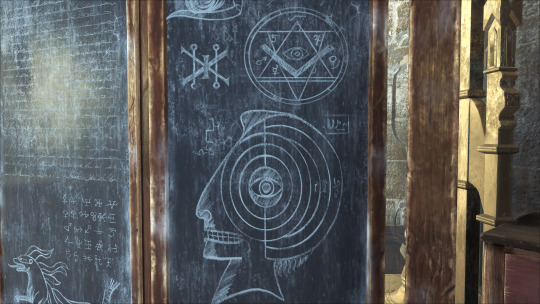
The alchemical symbol for copper and Venus. Strangely resembles the version of it used by the band Soundgarden for the King Animal album. It's also been rotated at 90 degrees.
Omnia unus est, taken from the original poster or the derivative works; misshapen. Reddit user Voxx418 provided very detailed overview of the symbols seen on the poster, but the poster itself first appeared in 2013 and doesn't have a lot to do with the old manuscripts.
Unsure, as of now, what exactly this is, but it reminds me of the Robert Fudd's artwork Diagram of consciousness and this page from Giordano Bruno's book The Ash Wednesday Supper. Has to do with cosmology and mind, I suppose.
Second image, from right to left:

A bunch of astrological and alchemical symbols (from right to left; note that it's not obvious if the symbol corresponds with, let's say, mercury as quicksilver and mercury as planet): ? || metal / caput draconis || mercury? || ? || mercury ? ? ? || venus || chi rho? || ? ? || mars || steel || ? ? jupiter || ? ? || tin / jupiter || ? saturn || ? || pisces || lead / saturn || lead / saturn
A kelpie.
Third image (I'm ignoring the symbols this time; they're astrology and alchemy; similar block of symbols can be found everywhere else in the castle):

A sigil! Tabula Saturni, to be precise. It originates from Athanasius Kircher's monumental work Oedipi Aegyptaci. However, the tabula was likely taken from this image; the photo of the chalkboard from the Transfiguration classroom from the HP movies. Anyway. This particular tabula can be found here, page 72, along with the rest of the planets in their classical order (also known as Chaldean order, planetary order, Babylonian, and many more; it's ancient and if it sounded a little off—as in, why is Saturn 3?—that's probably why). What do they mean though? It's… complicated and I'm not sure I'm able to explain but briefly so: you'd want these magic squares to summon divine powers to aid you. I understand sending directly to Agrippa is setting forth for an adventure but the man knew tenfold better than I ever would. So, the chapter of the Occult Philosophy where he explains it plus a humongous book about magic squares with hundreds of them calculated for different deities and planets.
The monogram of the emperor Justinian (the lower) and… Holy Trinity (the upper).
Forth image:

A moonstone sitting in the centre of a circle that's been cut in half… Doesn't make a lot of sense, likely a bug caused the cut. Next.
Fifth image:
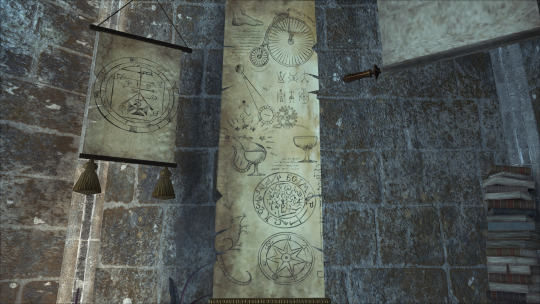
The long scroll's imagery is inspired by this frame (the images are identical bar the movie's version wasn't flipped back):

But then, these symbols again:

Not sure what they mean nor how to identify them yet. I recall seeing them in the Alchemy classroom. For now, I'll call them a WIP.
This is the Chaldean order diagram (rather distorted):

What's the symbol on the left?
That's an interesting question and a very silly story. Sit back, it's too much silliness for one standing.
How am I able to snipe all these things, might had you wondered? It's an intricate question. Evidently I'm busying myself with occult texts and imagery; lack of interest in practice of occultism slows me down as well as lack of interest in theology — the two are linked — but still. There is a certain corpus of text, famous and influential authors, and most importantly: the sense of continuity. I'm not nearly as erudite as I could be but navigating via learning the basics of who came up with what helps to determine, let's say, if certain symbology have been a recent development. Anyway and howevor. Magic, or magick, had become a very interesting subject to me and worst of all, it's logical. RIgidly, excruciatingly logical—after had been made familiar with the references it uses and refers to just to explain itself. Science of today left it all behind but should it mean we should or must abandon so much intricate, funny, cruel history and call it simply a whimsy.
Besides, I think I have cracked the artists' logic in how they picked all these images.
The answer is bluntly simple: they know magic is closely associated with certain symbology but they don't think it has an ounce of sense; or maybe they didn't have enough time to think how to weave with it because hermetic magic — Western magic — is an amalgamation of philosophy, theology and alchemy (and a lot more). Whichever was the case, I'm not satisfied with it for a reason as simple: if you absolutely have to work with something you have barely an idea about and you are not going to commit to it, perhaps it would be a wise decision not to put the result on the character's and hence the player's eye level. Especially when you did few visual quips here and there ( 1) at Falbarton castle, on the message board hangs a decree issued by the Ministry of Magic declaring the area unsafe for travels—and just underneath it, a letter, that reads "This isn't funny"; 2) if you doff everything and run around, all NPCs will have a line or two to remind you to change; 3) you can navigate the roads outside of the castle by going where signpost tell, and you'd often see Ministry's decrees and warnings for dangers in the area; 4) the entire mechanic of Ancient Magic is to be able to see the otherwise unseeable). Yet, the most obvious place everyone just might get stuck to—the boards at a school, at a place where you're certainly expecting at least some degree of systematisation—are riddled with drivel and or nonsense.
I'm harsh about this, yes. You'll understand why in just a few seconds.
During my excursions to the occult I commonly saw the same motif. A circle, something is drawn inside of it, especially in demonology. This is usually referred to as being Solomonic magic or its influences. So, when I saw this sigil, my immediate reaction was — Goetia!
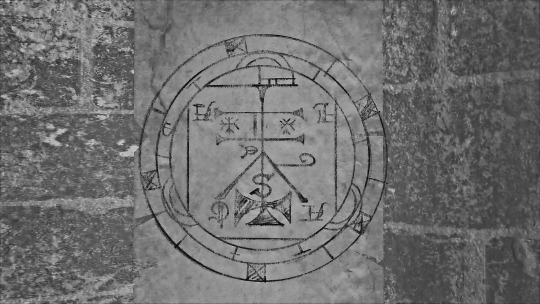
Goetia demons are in great plenty but no sigil matched this drawing. The circle also looked strange, as if taken from some place else, but so scarce a detail only leaves you wonder if you'd be able to find any thing at all related to this drawing. Which you know for certain had been taken from somewhere — it must had been.
And I was correct.
But my search wasn't originally intended to lead me to find where this sigil is from. I tried to determine what were the symbols etched on the Harlow's wand. Few grimoires leafed through, all interesting in their own sense, and then, accidentally, without a call, this page just loaded and stared at me:

That's it, I thought, found it. Weird, that they had to flip it. To write a post about it I only ever needed to find the original manuscript, but I was only able to find its translation. The manuscript is called The Cambridge Book Of Magic, or CUL MS Add. 3544, and delves into the forbidden art of necromancy besides the topics of medicine, herb gathering, and apotropaic magic. I found the aforementioned page on an obscure forum where it was uploaded in the low resolution, so I thought, I needed the bigger resolution; I like to look at the details and trying to read the text without hurting my eyes too much; and you see, the original manuscript seems to remain undigitalised to this day, only the translation made in 2015 is available for viewing online. Which is, I'll say, is a tad bit sad, but ultimately, fine.
I did try to find the manuscript, though. Besides my own curiosity, it's better to have a clear source as it's clear the artists didn't take in the translation: that particular sigil doesn't appear there where you'd expect it to be. In the end, all links led to this article:
Understood I wasn't given any other choice, I clicked on the image, in hopes it would be of higher resolution. I encourage you to do the same right now, if you are able or can.
It's flipped. The website returns the image flipped 180 degrees. Here how it looks like:

I hope that now you understand why I am rather… upset about this, pun not intended. It's beyond lazy yet the approach simply befuddles me: instead of buying from shutterstock kind of asset stores, they chose the struggle of selecting and finding real manuscripts and on the internet of all places only to barely bother about its contents. Unnecessary efforts, unwarranted butchering.
Sixth image (from the same website):


The translations for the aforementioned spells and sigils can be found here.
Seventh image:


The symbol of copper / Venus scorches the Chaldean order and Theorem XVIII of Monas Hierogliphica:
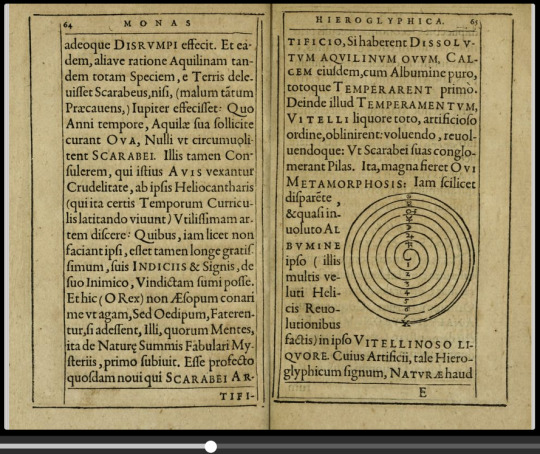
I think there were more but these images were kind of specific to Fig's class and I wanted to see what they meant or referenced.
Given that Theory for Magic is taught to 1st years (Hogwarts Legacy does not comment on it at all; in Harry's time, he had this subject in his 1st year but not in any subsequent year), they're in for a crash.
27 notes
·
View notes
Text
Anticipated New Releases of 2024
**As anticipated by Me. Mostly SFF. Links are to goodreads because that's what I use, sorry. Anything marked "new to me" I haven't read anything by that author before and therefore can't vouch for the quality. I just think the premise is neat.**
Emily Wilde's Map of the Otherlands, Heather Fawcett (16 January)
Sequel to the charming novel about the fairy anthropologist.
Exordia, Seth Dickinson (23 January)
Well, it isn't a new Baru Cormorant, but this modern SF about first contact may be the next best thing.
City of Stardust, Georgia Summers (30 January)
New to me. A young woman descends into the underworld in order to break her family's fatal curse.
The Tainted Cup, Robert Jackson Bennett (6 February)
New to me. A sherlock holmes flavored duo solves the mystery of the murder of an imperial official in a labyrinthine fantasy realm.
What Feasts at Night, T Kingfisher (13 February)
The sequel to the mushroom horror book What Moves the Dead.
The Warm Hands of Ghosts, Katherine Arden (13 February)
A ghost story set in WW1 about a woman searching for her missing brother.
The Fox Wife, Yangsze Choo (13 February)
New to me. A detective in 1908 Manchuria investigates a young woman's death in an area full of mythical foxes.
Redsight, Meredith Mooring (27 February)
New to me. Unpowered priestess and Imperial pawn is set on a collision path with a pirate with a grudge for the Imperium (Gay romance).
Sunbringer, Hannah Kaner (12 March)
Sequel about the professional godkiller Kissen.
Jumpnauts, Hao Jingfang (12 March)
New to me. A SF novel in translation from Chinese, with three scientists joining forces to deal peacefully with a first contact situation.
The Woods All Black, Lee Mandelo (19 March)
I liked Mandelo's debut novel very much so I'm excited to read this queer horror novella set in 1920s Appalachia.
Floating Hotel, Grace Curtis (19 March)
New to me. A series of cozy character vignettes on a space cruise ship after a murder has occurred. One of the four (!) space hotel murder crimes books coming out this year.
The Emperor and the Endless Palace, Justinian Huang (26 March)
New to me. Reincarnation gay romance set in 4 BCE China, the 1740s, and modern-day LA.
Alien Clay, Adrian Tchaikovsky (28 March)
Far future space xenoarchaeology by a man trapped on a prison planet.
Someone You Can Build a Nest In, John Wiswell (2 April)
New to me. Bizarre lesbian cannibalism monster romance from the point of view of the monster.
The Familiar, Leigh Bardugo (9 April)
Glad to see Bardugo writing more adult fantasy, and this one is especially exciting because it's a fantasy set in early modern Spain with a Jewish main character. Fun to see a more original historical period.
A Sweet Sting of Salt, Rose Sutherland (9 April)
New to me. Lesbian selkie romance.
Death in the Spires, KJ Charles (11 April)
Charles branching out from romance into historical Oxford murder mystery about a group of friends with dark secrets.
Audrey Lane Stirs The Pot, Alexis Hall (22 April)
The new Hall thinly veiled british baking show romcom. Libby says it's releasing in April but I've heard nothing from the author so I think it may be Alecto'd (shifted to next year)
Necrobane, Daniel M Ford (23 April)
Sequel to the dungeons and dragons-esque low fantasy lesbian necromancy book.
A Letter to the Luminous Deep, Sylvie Cathrall (25 April)
New to me. Sweet underwater epistolary academic romance.
How To Become the Dark Lord and Die Trying, Django Wexler (21 May)
New to me. A young hero caught in a fantasy time loop gives up and tries being the villain in an attempt to escape.
Goddess of the River, Vaishnavi Patel (21 May)
Another woman-centered retelling of Hindu mythology, this time based on the river goddess Ganga.
Escape Velocity, Victor Manibo (21 May)
New to me. Evil and toxic private school alumni jockey for position in a space hotel event in an attempt to escape a dying Earth.
The Fireborne Blade, Charlotte Bond (28 May)
New to me. Gay dragon slaying knight novella.
Evocation, ST Gibson (28 May)
New to me but looks very cool. Attorney and medium David attempts to escape his deal with the devil with the help of his ex boyfriend and his ex boyfriend's wife (Poly romance).
Service Model, Adrian Tchaikovsky (4 June)
In an SF future, a robot kills its human owners and ventures out into a world where human supremacy is beginning to crumble.
Lady Eve's Last Con, Rebecca Fraimow (4 June)
New to me. A con artist seeks revenge on the man who hurt her sister, who's coincidentally also on a space cruise ship (Sapphic romance subplot).
Triple Sec, TJ Alexander (4 June)
An actual mainstream published poly romance (!!) by trans author Alexander.
Running Close to the Wind, Alexandra Rowland (11 June)
Gay! Pirates! Scheming! Alt fantasy world! Monks! I liked Taste of Gold and Iron a lot and I'm very excited for this one.
The Knife and the Serpent, Tim Pratt (11 June)
New to me. Space opera about an interdimensional organization. Also, there's a sentient starship.
The Witchstone, Henry Neff (18 June)
A childhood favorite of mine's adult debut, featuring a demon who suddenly has to shape up at his curse keeper job after eight hundred years of slacking.
Rakesfall, Vajra Chandrasekera (18 June)
VERY excited to read more weird queer sff from this author after a fantastic debut. Looks weird. I'm in.
Foul Days, Genoveva Dimova (25 June)
New to me. A witch in a Slavic fantasy inspired world flees her evil ex, the Tsar of Monsters. There's also a plague and a detective.
Saints of Storm and Sorrow, Gabriella Buba (25 June)
New to me. Filipino inspired anticolonialist fantasy novel about a nun who is secretly practicing the religion of her goddess.
The Duke at Hazard, KJ Charles (18 July)
A queer regency with an incognito duke by one of my particular favorite romance authors.
Long Live Evil, Sarah Rees Brennan (30 July)
!!! Very excited to see a new adult fantasy by Brennan. A reader is dragged into a fictional world and finds herself the villain.
A Sorceress Comes to Call, T Kingfisher (20 August)
A retelling of The Goose Girl from reliably good fairy tale stalwart Kingfisher.
Buried Deep and Other Stories, Naomi Novik (17 September)
Collection of Novik's short stories.
Swordcrossed, Freya Marske (8 October)
VERY excited to see a new book by talented writer Marske. A man falls in love with the duelist hired for his arranged wedding. MEANWHILE. details of the fantasy world wool industry.
Feast While You Can, Mikaella Clements and Onjuli Datta (29 October)
New to me. Small town queer cave horror.
The Last Hour Between Worlds, Melissa Caruso (19 November)
Multiple reality murder mystery spy vs spy type antics, with lesbians.
#book recommendations#on the tbr#now I would Like to put alecto the ninth on this but as we know. NO news (sobs)#long post#updated 3/8 with more books I've added since I posted this
127 notes
·
View notes
Text
TIL from a podcast featuring historian and Byzantine archaeologist Yannis Theoharis:
Athens was one of the most religiously conservative cities of the Byzantine Empire. It adhered to the ancient Greek religion for longer than most other areas. Contrary to popular belief, its eventual conversion to Christianity did not happen violently. Christianity was getting more and more ground amongst the believers progressively. Meanwhile, the ancient temples and shrines were progressively emptying but as long as there were believers they were functioning properly and had guards and went through restoration works and all, as stated by Neoplatonic philosopher Proklos (with the exception of nude sculptures which had been destroyed already by proto-Christians). The historian also claims the conversion of the temples to churches happened later than what was previously believed, around the 7th-9th centuries. As the vast majority of the population had eventually converted to Christianity, the temples were left abandoned. The empire ordered their conversion to churches so that funding their preservation could be justified. Furthermore, there wasn’t as much of violent banning of ancient schools as it was thought. Justinian did not ban the function of the Neoplatonic school in Athens but ceased the state funding unless the school accepted to add Christian theology to its curriculum. The Neoplatonic school refused but it was not banned. It kept functioning using its own private funds until this wasn’t enough and the school had to close. Evidence for this is that it is documented that the school functioned for several decades or more than a century (don’t remember exactly) after Justinian’s imperial command, which was previously viewed as an immediate or violent shutdown. Meanwhile, the Neoplatonic school in Alexandria (in Egypt) agreed to add Christian theology to its curriculum and it kept functioning undisturbed until the 7th century and the Arab conquest.
Also, he has more insight into the similarities observed between Eastern / Greek and even all Orthodoxy and the Ancient Greek religion, such as idol / icon worship, lesser deity / saint worship, virgin female deity / super saint worship, patron gods / saints etc He says there was an interesting cycle of Christianised Hellenism followed by Hellenized Christianity. Some of these elements of Christian Orthodoxy were emphasized more than in the early years of Proto-Christianity or even exaggerated by the Byzantine Greek Christians in order to attract the pagan Greeks and make them understand more easily the philosophy of the new religion and find common ground between them. It worked.
Lastly, he disputed the dated assumptions that the Visigoth king Alaric I was assisted by monks to destroy Athens during his invasion in 396. This was falsely concluded because in documents it was found that Alaric was accompanied by men clad in black. Theoharis says these were actually Thracian soldiers (Alaric indeed fared long in Thrace and the Thracians were by large mercenaries) and supports it is very unlikely based on historical evidence of the time that Athenian or Greek Christians would collaborate with a Visigoth invader to help him destroy historical areas of Athens, even if they were pagan.
These are the most important bits from memory, I am linking the podcast here, it is in Greek.
#Greece#Europe#history#Greek history#Byzantine history#Christian orthodoxy#Ancient Greek religion#Greek orthodoxy#Eastern Orthodoxy#Byzantine empire#eastern Roman Empire#justinian#Alaric I#proklos#neoplatonism#Athens#attica#central Greece#Sterea Hellas#mainland
107 notes
·
View notes
Note
Erm, question! I've recently listened to audiobooks of Herosotus's Histories and Thucydides History of the Peloponessian War, but I'd like to move forwards in time. What are some good medieval Byzantine sources of history, or Arabic sources? Or later Ottoman ones? Also, do you know of any historians that specifically chronicle the life and deeds of Skanderbeu?
It's not necessary, but the best recs for me would be authors who have the Vibes:tm: of Herodotus.
Also, even more ideally, do you know of any online resources where I can find such authors for little or no cost (I already use my library as best as I can)?
Anyways I love your blog and every single little historical thing you reference makes me wanna learn more. I hope you have a lovely day!!
if you want to move chronologically through the Mediterranean, I would suggest Livy for your next listen, but if you want to skip ahead to the Byzantines…
for entertaining histories with a strong authorial voice, I recommend Procopius (6th century), Psellos (11th), and Anna Komnene (12th century). they’re probably the most famous of the Byzantine historians, and certainly the authors with the most accessible translations and commentary. Procopius originally wrote about the wars of the immensely consequential emperor Justinian I, but eventually soured on Justinian’s leadership and wrote the downright libelous, but very colorful, Secret History.
Psellos wrote just before the Byzantines started losing territory to the Turks in the late 11th century, and as a high-ranking member of government, he was personally acquainted with the politicians he wrote about. now, as in his own day, he’s considered one of the most important scholars and philosophers of the empire. personally, I thought Chronographia was a great read, and I think it’s been turned into a podcast (“Fourteen Byzantine Rulers”) as well. it’s much better history qua history than Procopius, in my opinion.
The Alexiad is very famous too, and like Procopius, it’s mostly limited to the life of one emperor. Anna Komnene was the daughter of Alexios I Komnenos, who was instrumental in starting the first crusade. her history takes the form of an epic poem, and is interesting for its content and its authorial context—surviving Byzantine epics are rare, and epics written by disfavored princesses are unheard of.
if you’re interested in my favorite period, the 9th-10th century, I recommend Skylitzes or Leo the Deacon. for the period up to the fourth crusade, Choniates is a good resource.
I’m far less knowledgeable about Arabic sources—I pretty much only know Ibn Khaldun (14th century, extremely influential in his historiographical methods) and Ibn Munqidh (eyewitness to the crusades, and not much for writing long narrative histories, but a great source of weird anecdotes).
and Ottomans… idk. all of my knowledge comes from secondary sources, but I can recommend The Ottomans: Khans, Caesars, and Caliphs as a pretty decent overview of the empire (also on audiobook). Osman’s Dream covers the same territory. same with Skanderbeg.
for accessing Byzantine books, very few will be in your local library, but the internet archive and libgen have a surprising amount. a number are also available as pdfs directly from Google—sometimes these use dated public-domain translations, but beggars can’t be choosers. the links in this post all go to free copies of the works in question.
#my classes on islamic civilizations weren’t heavy on the historical primary sources#one had them (but only as snippets) and the other mostly read quippy works of romantic advice and medical anecdotes#anyway I only proofread this loosely let me know if I forgot something
10 notes
·
View notes
Text
This is kind of weird. One of my posts – possibly more, but certainly one – has disappeared. I remembered making it, and then I searched on siikr for it based on it having the name “Justinian” in it, and I found it on siikr:

The link is dead, though.
As far as I can tell, the entire thread has disappeared. I remember @argumate posting in this thread as well, and sure enough, the post was on siikr:

But the link is dead.
Anyone know what’s going on here, whether the posts can be restored, whether they were removed for a reason, or anything else? @staff
(I drafted this when siikr was still a thing.)
17 notes
·
View notes
Note
i) Jews revolt and Hadrian expels & genocides the Jews from Judæa
ii) he settles Romans in their place
iii) the Romans convert en masse to Samaritanism
iv) Samaritans revolt and Justinian expels & genocides the Samaritans from Palestina Prima
v) the survivors travel to Italy, where they settle amidst the Ostrogothic-Roman-Lombardic transition
vi) they convert to Judaism to link up with the far smaller existing Italian Jewish community
vii) from there they spread to the rest of Europe, becoming the ancestors of the Aschkenasim
Israelis = Romans qed
youtube
18 notes
·
View notes
Text
July reads
*= reread
Queenie by Candice Carty-Williams
The Route of Ice and Salt by José Luis Zárate
How You Get the Girl by Anita Kelly
Are You My Mother? by Alison Bechdel
Icarus by K. Ancrum
Housemates by Emma Copley Eisenberg
The Ascent to Godhood by Neon Yang
I’m Thinking of Ending Things by Iain Reed
A Fatal Thing Happened on the Way to the Forum: Murder in Ancient Rome by Emma Southon
Bang Bang Bodhisattva by Aubrey Wood
The American Daughters by Maurice Carlos Ruffin
Get in Trouble: Stories by Kelly Link
The Art Thief: A True Story of Love, Crime, and a Dangerous Obsession by Michael Finkel
Who Do You Serve, Who Do You Protect: Police Violence and Resistance in the United States edited by Maya Schenwar, Jo Macaré, and Alana Yu-Lan Price
Chasing Pacquiao by Rod Pulido
Subtle Blood by K.J. Charles
The Emperor and the Endless Palace by Justinian Huang
Generation Loss by Elizebeth Hand
This Is Why They Hate Us by Aaron H. Aceves
The Empress of Salt and Fortune by Nghi Vo*
3 notes
·
View notes
Note
Hi @theowritesfiction how are you doing? So I was scrolling through Spotify the other day and came across “the history of Byzantium” podcast. Remembering our earlier discussion, I found an episode on Justinian II. Link is here
https://open.spotify.com/episode/4x6lJEqY4weIcuEqHp3Yjv?si=J8_rmroYQoadWDmDpZ7MiA&context=spotify%3Ashow%3A2APexkhnuepwYbPhbrq3Mm
I hope the episode can be of some modicum of help should you need it. The actual Justinian II discussion begins at 1:50 into the audio. After the adds.
Oh yes, thank you, that's one of my favorite history podcasts. :) I would definitely use that episode as a source for inspiration, in case I end up writing an atla x rl history crossover!
2 notes
·
View notes
Note
🖊 ahh I don't know who so I'm gonna give two categories: Wayfarer of your choice OR new OC you are excited to talk about!
ty for dropping by! <3 since i've been missing my wayfarer kids something fierce, so have some wayfarer kiddos! here's some honoria for you :)
picrew link

🖊 she's from sathir but her father, justinian, isn't. he's an ayadan melusine warrior that did helped the court of sarin, and over time, after he and his first wife parted ways, he married a minor-ish elven noblewoman of sarin's court named galla and they had honoria and her two siblings :)
honoria is also very much attached to her father, who didn't shun her for being a magianis, who loved and defended her, as did her mother. the decision to join the wayfarers was honoria's own, and even though she grew close to cenric and views him as a second father after being his apprentice, she never really shook off her father's name, ionneon, in honor of him.
when the spire fell (since in my extended verse honoria and thesor sereno are older wayfarers who are spire survivors) she took a very injured thesor to her father in sathir to recover, where they spent some time living with the clan. i have an old fic about it, if anyone's curious to read! i love oria and thesor's relationship, they're platonic life partners and they're so funny together. i care them lots!!!
3 notes
·
View notes
Text
There is actually many genetic things that could have possibly linked to the idea of vampires. I actually came up with an alternate history biological scifi premise for lota of vampires (around bubonic plague which some historians believe was a factor in the neolithic decline and there were 3 notable big outbreaks, first being the fall of the justinian empire. Unfortunately i don't know how to turn the premise into a story)
Studies on people with albinism show much higher skin flora that is associated with harm from the sun causing increased risk of skin cancer. But potentially this means that skin flora might essentially fight for resources if an outside infection is trying to occur (bubonic plague) making more resistant to some diseases (the belief of not outside, red eyes, living forever or disease immune when everyone is dieing...) this can be amplified by bigotry (secluded meaning less likely to die but also rich people. Furthering dynamic of vampires either being lords or people in secluded caves)
While garlic allergies and intollerance can be developed. Slower by oral. Much more by physical. Hence why some of lords people that farmed garlic ended up getting allergies on hands.
But lastly...vitamin A.
45% of people have a poor conversion of it from plants to the meat based need (need more of) some much more worse.
This means in places where vitamin A is less abundant in plants (less plants that have much of) as well as for some individuals. Historically. They had to get it from other sources.
Namely
Dairy (not everywhere had, and lactose intolerant and allergy)
Eggs (not everywhere, and actually a decent food allergy in europe)
Liver (requires killing but can feed a lot of people the A needed but easier in fishing places. Hence retinol sold today is made from fish liver)
And blood. Specifically averaging 200-600 micrograms per liter. With A requirements being 700-900 daily.
This prevents eye health deterioration.
So realistically. 2 liters a day
you know it really isnt immoral, if you do it right, to raise cows and sheep for meat. so. well. i think there should be a story about, vampires who have a town of humans that they keep well-maintained, so long as the humans donate their blood once a month, like vampire blood farm stuff
but instead of antagonistic everyone's like. no he's a nice man you leave the count alone. he keeps us safe and cared for and he just needs a lil snack now and then, it dont hurt anyone. like a cow that loves the farmer and the farmer that loves the cow, even with both knowing one will end up on the other's table. because its like. its like. cows just have such pretty eyes, you know? they love you so much. i think it should be like that
59K notes
·
View notes
Text
Alkhuinat and Elfluseyat


Located along the shore of Lake Bardawil, near the road linking Qantara and Arish, lie two adjacent archaeological sites: El-Khweināt and El-Fulūsiyyāt, both now part of the Zaranik Protected Area.
El-Khweināt is home to the remains of tightly clustered buildings and several ancient tombstones engraved with inscriptions in ancient Greek, many of which are shaped in human form. In contrast, El-Fulūsiyyāt boasts the remnants of several churches that date back to the 5th century AD. Roman geographers once referred to it as Strasine.
Perched on a prominent mound known as Tell El-Fulūsiyyah, this area held great strategic importance. It served as a crucial intersection between the shoreline route connecting to Pelusium (Al-Farma) and the ancient military road. Although little remains today, traces of a fortress built by Emperor Justinian in the 6th century AD are still visible in the eastern sector, constructed as a defense against Persian invasions.
Local Bedouins named the site based on the large number of Roman coins found there.
This site is an exceptional stop for travelers embarking on Egypt Tours who are eager to explore rarely visited historical gems. It can easily be included in various Egypt Tours Packages for history lovers.
For those seeking timeless adventures, these sites provide the perfect setting for Egypt Classic Tours, immersing visitors in early Christian and Byzantine heritage.
Whether part of guided Egypt Day Tours or curated Egypt Day Tours from Cairo, these ruins offer an extraordinary journey into Egypt’s northern frontier.
During spring, travelers can enjoy the tranquil charm of the area as part of their Egypt Easter Tours itinerary.
Additionally, the proximity to the Mediterranean makes it an ideal stopover for Egypt Shore Excursions, combining culture with coastal beauty.
0 notes
Text
The Kingdom of Aksum!!!
What Was the Kingdom of Aksum and Why Does It Matter Today?
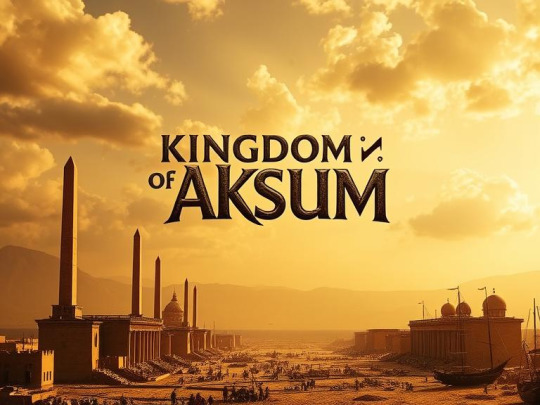
The Kingdom of Aksum, one of the most powerful African civilizations, flourished between 100 BCE and 940 CE in present-day Ethiopia and Eritrea. This empire played a crucial role in shaping trade, politics, culture, and religion in the ancient world. Aksum’s significance extended beyond Africa, influencing major global civilizations, including Rome, Persia, and India. But how did this great empire rise to prominence, and what led to its decline?
The Origins and Rise of Aksum (100 BCE – 300 CE):
The Kingdom of Aksum emerged in the Horn of Africa, benefiting from its strategic location along the Red Sea trade routes. It was influenced by earlier civilizations like the Kingdom of D’mt (circa 10th–5th century BCE). Aksumite rulers established a centralized monarchy, expanding their territory across northeastern Africa and southern Arabia.
First Mention (1st Century CE): Aksum was first mentioned by Greco-Roman traders in the Periplus of the Erythraean Sea, describing it as a major trading hub.
Expansion under King Gadarat (200 CE): Aksum extended its control over key ports in Arabia.
Political Influence and Diplomatic Relations:
Aksum was a major political force, maintaining diplomatic and military relationships with world powers:
Roman Empire: Aksum supplied gold, ivory, and exotic animals to Rome. Emperor Justinian I (527–565 CE) acknowledged Aksum’s influence.
Persian and Indian Trade: The kingdom played a key role in silk and spice trade networks.
Conquests in Yemen (520 CE): Under King Kaleb, Aksumite forces overthrew the Himyarite Kingdom in South Arabia.
Aksum’s military strength was reinforced by iron weaponry, war elephants, and naval fleets, helping it dominate regional conflicts.
Archaeological Discoveries and Palace Complexes:
Aksum’s architectural feats showcased its advanced engineering and royal wealth:
Ta’akha Maryam Palace (4th Century CE): A grand multi-level palace with sophisticated drainage systems.
Dungur Palace (6th Century CE): A palace believed to be linked to Queen of Sheba legends.
Obelisks (Stelae of Aksum): Monumental stone pillars, including the Obelisk of Aksum (24m tall), signifying royal burials.
Tombs of Kings: The underground tomb of King Ezana (4th Century CE) contained inscriptions in Greek, Sabaean, and Ge’ez.
Aksum’s Economy and Global Trade (100 – 700 CE):
Aksum was a trading superpower, controlling commerce in the Red Sea, Indian Ocean, and Nile Valley. Its economy thrived due to:
Gold and Ivory Trade: Aksum exported gold, frankincense, myrrh, and ivory to Rome and India.
Coinage System (270 CE): Aksum was the first African civilization to mint gold, silver, and bronze coins with Ge’ez inscriptions.
Agriculture and Technology: Terracing and irrigation supported wheat, barley, and teff farming.
Aksum’s wealth led to the rise of a merchant elite, influencing urban development and cultural growth.
Art, Pottery, and Cultural Achievements:
Aksumite artisans produced intricate pottery, jewelry, and religious inscriptions:
Red-slipped pottery with elaborate carvings.
Gold and bronze statues depicting rulers and deities.
Ge’ez script, the foundation of Ethiopia’s written language.
Aksum’s art was deeply influenced by Egyptian, Greek, and South Arabian styles, reflecting its multicultural connections.
Religion: From Pagan Traditions to Christianity
Early Aksumites practiced polytheism, worshipping gods like Mahrem (associated with the king). However, the kingdom became one of the first Christian states:
King Ezana’s Conversion (330 CE): Adopted Christianity under the influence of Byzantine missionaries.
Construction of Churches: The Church of Our Lady Mary of Zion (4th century CE) became Ethiopia’s spiritual center.
Ark of the Covenant Legend: Ethiopian tradition claims that the Ark of the Covenant was hidden in Aksum.
Christianity helped unify Aksum but also led to conflicts with non-Christian neighbors.
Engineering, Science, and Military Technology:
Aksumites were pioneers in agriculture, construction, and warfare:
Terrace farming techniques prevented soil erosion.
Sophisticated water reservoirs ensured year-round farming.
Iron weapons (swords, lances, and spears) strengthened military dominance.
Aksum’s naval presence enabled it to control coastal trade routes in the Red Sea.
Decline of Aksum: What Led to Its Fall? (700 – 940 CE):
Several factors contributed to Aksum’s decline: Climate Change & Agricultural Crisis:
Droughts and soil depletion led to food shortages. Overgrazing and deforestation weakened agricultural productivity.
Rise of Islamic Caliphates (7th Century CE):
The expansion of Arab Muslim traders shifted Red Sea commerce away from Aksum.
Aksum lost control of key ports** like Adulis to Islamic Mighty Power.
Internal Conflicts & Political Fragmentation:
Local revolts and weakened royal authority destabilized the kingdom.
Final Collapse (10th Century CE):
The Zagwe Dynasty replaced Aksum’s rule, shifting Ethiopia’s power center southward.
By 940 CE, Aksum’s capital was largely abandoned.
The Legacy of Aksum in Today’s World:
Despite its fall, Aksum’s impact still resonates:
Ethiopian Orthodox Christianity traces its roots to Aksumite conversions.
Ge’ez script is used in Ethiopian religious texts.
Aksum’s archaeological sites remain a symbol of African heritage.
Modern Ethiopia celebrates Aksum’s legacy through historical sites, festivals, and cultural traditions.
Conclusion: Why Does Aksum Still Matter?
The Kingdom of Aksum was more than just an ancient civilization—it was a global power that connected Africa with the world. Its achievements in trade, technology, architecture, and religion influenced societies for centuries. Though it declined, Aksum’s legacy lives on in modern Ethiopia, Christianity, and African history.
Understanding Aksum helps us appreciate the rich and complex history of African civilizations that shaped the world we know today.
#lostcivilizations#archaeology#art history#historiessecret#ancienthistory#archaeologylovers#culturalheritage#histories-secret#ancientmysteries#ancienttrade#AncientAksum#AfricanHistory#LostCivilizations#EthiopianHistory#HistoricalEmpires
1 note
·
View note
Text
Turkey — Istanbul and Cappadocia, where history meets stunning nature.

Istanbul — The city is a perfect blend of history and modernity. Spring is the season of the Istanbul Tulip Festival, where millions of tulips decorate the parks, especially Emirgan Park and Gülhane Park. Walking along the Bosphorus, exploring Hagia Sophia, Topkapi Palace, and the Grand Bazaar is even more enjoyable in the pleasant spring weather.
Cappadocia — Spring is one of the best times to visit this magical region. The weather is perfect for hot air balloon rides over the surreal rock formations and fairy chimneys. The Göreme Open-Air Museum, underground cities, and valley hikes (like Rose Valley and Pigeon Valley) are stunning with blooming wildflowers.
Hagia Sophia

https://trip.tp.st/oH08bC5j
Originally built as a cathedral in 537 AD by the Byzantine Emperor Justinian I, Hagia Sophia later became a mosque, then a museum, and is now an active mosque again. It is famous for its massive dome, beautiful Byzantine mosaics, and intricate Islamic calligraphy. You can admire the mix of Christian and Islamic art, including the stunning Deësis mosaic and the large Ottoman-era mihrab and minarets. Best time to visit: Early morning to avoid crowds Topkapi Palace
https://trip.tp.st/oH08bC5j Served as the primary residence of Ottoman sultans for almost 400 years (from the 15th to the 19th century). The palace features lavish courtyards, imperial chambers, and the famous Harem, where the sultan’s family lived. Home to precious artifacts, including the Prophet Muhammad’s relics, the Topkapi Dagger, and the Spoonmaker’s Diamond Offers breathtaking views of the Bosphorus from its terraces. Best time to visit: Mid-morning or late afternoon for fewer crowds. [Insert Your Company Link Here https://trip.tp.st/oH08bC5j]
0 notes
Text
This is a list of the largest known epidemics and pandemics caused by an infectious disease in humans. Widespread non-communicable diseases such as cardiovascular disease and cancer are not included. An epidemic is the rapid spread of disease to a large number of people in a given population within a short period of time; in meningococcal infections, an attack rate in excess of 15 cases per 100,000 people for two consecutive weeks is considered an epidemic.[1] Due to the long time spans, the first plague pandemic (6th century – 8th century) and the second plague pandemic (14th century – early 19th century) are shown by individual outbreaks, such as the Plague of Justinian (first pandemic) and the Black Death (second pandemic).
Infectious diseases with high prevalence are listed separately (sometimes in addition to their epidemics), such as malaria, which may have killed 50–60 billion people throughout history, or about half of all humans that have ever lived.
Major epidemics and pandemics
By death toll
Ongoing epidemics and pandemics are in boldface. For a given epidemic or pandemic, the average of its estimated death toll range is used for ranking. If the death toll averages of two or more epidemics or pandemics are equal, then the smaller the range, the higher the rank. For the historical records of major changes in the world population, see world population.
Depopulation of the Americas
Main article: Population history of Indigenous peoples of the Americas § Depopulation by Old World diseases
Not included in the above table are many waves of deadly diseases brought by Europeans to the Americas and Caribbean. Western Hemisphere populations were ravaged mostly by smallpox, but also typhus, measles, influenza, bubonic plague, cholera, malaria, tuberculosis, mumps, yellow fever, and pertussis. The lack of written records in many places and the destruction of many native societies by disease, war, and colonization make estimates uncertain. Deaths probably numbered in the tens or perhaps over a hundred million, with perhaps 90% of the population dead in the worst-hit areas. Lack of scientific knowledge about microorganisms and lack of surviving medical records for many areas makes attribution of specific numbers to specific diseases uncertain.
There have been various major infectious diseases with high prevalence worldwide, but they are currently not listed in the above table as epidemics/pandemics due to the lack of definite data, such as time span and death toll.An Ethiopian child with malaria, a disease with an annual death rate of 619,000 as of 2021.
Malaria has had multiple documented temporary epidemics in otherwise non-affected or low-prevalence areas, but the vast majority of its deaths are due to its constant prevalence in affected areas.
Tuberculosis (TB) became epidemic in Europe in the 18th and 19th century, showing a seasonal pattern, and is still taking place globally. The morbidity and mortality of TB and HIV/AIDS have been closely linked, known as "TB/HIV syndemic". According to the World Health Organization, approximately 10 million new TB infections occur every year, and 1.5 million people die from it each year – making it the world's top infectious killer (before COVID-19 pandemic). However, there is a lack of sources which describe major TB epidemics with definite time spans and death tolls.
Hepatitis B: According to the World Health Organization, as of 2019 there are about 296 million people living with chronic hepatitis B, with 1.5 million new infections each year. In 2019, hepatitis B caused about 820,000 deaths, mostly from cirrhosis and hepatocellular carcinoma (primary liver cancer). In many places of Asia and Africa, hepatitis B has become endemic. In addition, a person is sometimes infected with both hepatitis B virus (HBV) and HIV, and this population (about 2.7 million) accounts for about 1% of the total HBV infections.
Hepatitis C: According to the World Health Organization, there are approximately 58 million people with chronic hepatitis C, with about 1.5 million new infections occurring per year. In 2019, approximately 290,000 people died from the disease, mostly from cirrhosis and hepatocellular carcinoma (primary liver cancer). There have been many hepatitis C virus (HCV) epidemics in history.
0 notes
Text
The Basilica Cistern
A Glimpse into Byzantium’s Engineering Marvel The Basilica Cistern, also known as in Turkish or the “Sunken Palace,” is one of the most fascinating remnants of Byzantine architecture in Istanbul. Built between 527-565 AD under the orders of Emperor Justinian I, this immense underground water reservoir is not only a testament to the advanced engineering and architectural capabilities of the… Read more by link below:
0 notes
Text










The Islamic city shows itself to be both a homogenous whole and a juxtaposition of sub-units; each neighbourhood is, in some way, a miniature city, complete with everything a city contains.
Jamila Binous.
The latest in my Tunisia series; please see here, here, here, here, here and here for the rest.
Tunisia, which was always home to the Berber people (who make up much of Tunisian DNA but whose language and culture have sadly declined), has also been the home and/or battleground of dozens of other ethnic/religious groups, as below.
What is now Sousse was formerly the Roman city of Hadrametum, built on a site where the Phoenicians and Carthaginians, sea-borne colonists from the Near East, had earlier based themselves.
The Roman Empire also lasted centuries, sprawling as far as what is now my home country of Britain, but it collapsed in the fifth century AD and in 434, Hadrumetum was sacked by the Vandals, who founded a Germanic kingdom in Africa (and whose name has been immortalised as a word for mindless violence, although the historic Vandals were not really like that).
The city was rebuilt by the Byzantines, a sea-borne Christian power based in what is now Turkey, after their emperor Justinian reclaimed these lands in 533 along with most of what had been the Roman Empire, on which the Byzantines modelled themselves.
The Muslims, a largely land-based power, conquered Egypt between 639 and 642 AD and pushed west, but were for centuries threatened by Byzantine ships coming from Europe, which is why coastal forts such as Sousse and Monastir were so important; known as ‘ribats’, this is one of the foremost in Tunisia. The Muslims succeeded in driving the Byzantines out of this area in 730 AD (the majority of Tunisians have spoken Arabic and followed Islam ever since).
Hadrumat was destroyed in this process, but a new kasbah thus founded in on the Roman ruins by Islamic ruler Zidayat Allah I of the Aghlabid dynastyin 825 AD, and was home to 50 warrior monks who defended this city against the Byzantines and any other foe they might face. It spans the ribat and mosque.
The site was too good for the Aghlabids , who were based in Kairouan, to let it go to waste! They used Roman ruins captured from Malta, where I’m going next year, when they seized it in 870 AD; in the Mediterranean everything links in to everything else.
Very unusually in Islam, there is no minaret at this mosque; there was not felt to be a need for one, as the call to prayer (a spellbinding sound that sadly I didn’t hear as my hotel was too far from any mosque) can be heard across the old city from the ribat.
The Aghlabid invasion of Byzantine-held Sicily was launched from these shores in 827 AD; Sousse is geographically nearer to Sicily than it is to the heartland of sub-Saharan Africa, which is one of the reasons why it has among the highest concentrations of European DNA in Tunisia. A 2015 study in the Journal of Human Genetics found that there is more genetic diversity here than in any other part of Tunisia.
In the 11th century a new Christian power, the Normans (who also conquered England!) reclaimed Sicily from the Muslims in 1091 AD and Normans came to Sousse when their ruler, Roger II, set himself up in Africa from 1146 to 1148 AD before being cast out by the Almohads, whose Islamic empire was ruled by Berbers and spanned from what is now Morocco into Europe including what is now Spain.
(The building in 9 is Qubba bin Al-Qhawi, which is believed to date back to the 11th century AD but whose purpose is unknown, except that it might be a tomb; Binous calls it ‘very unusual and bizarre’ but it’s also striking).
There has been two-way traffic across the Mediterranean since Phoenician days, and the advent of Christianity and Islam furthered this; not only was there an empire spanning from Marrakech through Africa and Europe into what is now Spain, Sousse itself has gone back and forth.
In this time the Byzantines, who had been losing ground for centuries, finally collapsed the Muslim Ottoman Empire conquered them in 1453 AD.
In 1492, the last remnants of the Andalusian empire also fell; after the Christian Spaniards reclaimed their country they expelled all Muslims and Jews from their country; Kairouan is, of all the places I saw, the most strongly influenced by Andalusian/European culture.
(As a bastion of Muslim land-based power, Kairouan, which is near to Sousse, is closely linked to coastal forts such as this).
This is most clearly seen in the life of the author and diplomat who was born in 1485 AD and given the name Hasan Muhammad al-Wazzan al-Fasi, in what was then the Muslim state of Grenada, and after the Reconquista his family had to flee to Morocco.
When he grew up he was captured by Spaniards in 1518 and became a Christian, whereupon he voyaged around North Africa, sub-Saharan Africa, Europe and Asia, now called Leo Africanus and gave us an epic account of those places. Throughout this he was always a Mediterranean man at heart, and died in Tunis.
The Spaniards, who were resurgent at this time, battled with the Ottomans, who had also been gaining ground since conquering the Byzantines. At the Siege of Tunis in 1574, the Ottomans won so decisively that they established a centuries-long rule here before the French took over in 1881, and Tunisia gained its independence in 1956 (This is mainly a medieval post; please see my piece about the Martyrs’ Monument for modern Sousse).
In peacetime Tunisia, as well as the Muslims and Jews who had earlier fled from Europe, drew in many Italian and Maltese immigrants. To this date the local dialect, almost a separate language from Standard Arabic, is salted with Italian loanwords.
(Tunisia later became a land of emigration; sadly the majority of Jews have left since 1948, moving both to Israel and to America and Europe, while there are over a million Tunisian Muslims in other countries, an estimated 750,000 of whom in France; our tour guide was a Londoner of Tunisian parentage).
As you can see, a number of cats live here, I think without any one owner, but being fed and cared for by the public; sadly dogs, who are seen as unclean in Islam, do not fare so well; they are fewer in number than cats and usually wander around waste ground looking feral.
0 notes